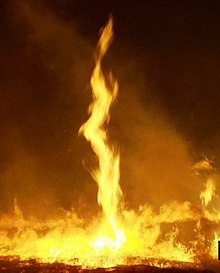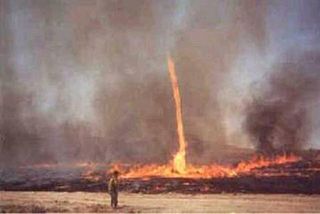Whirlwind induced by and often composed of fire From Wikipedia, the free encyclopedia
A fire whirl, fire devil or fire tornado is a whirlwind induced by a fire and often (at least partially) composed of flame or ash. These start with a whirl of wind, often made visible by smoke, and may occur when intense rising heat and turbulent wind conditions combine to form whirling eddies of air. These eddies can contract to a tornado-like vortex that sucks in debris and combustible gases.
| Fire whirl | |
|---|---|
 A fire whirl with flames in the vortex | |
| Area of occurrence | Worldwide (most frequent in areas subject to wildfires) |
| Season | All year (most frequent in dry season) |
| Effect | Wind damage, burning, propagation/intensification of fires |
The phenomenon is sometimes labeled a fire tornado, firenado, fire swirl, or fire twister, but these terms usually refer to a separate phenomenon where a fire has such intensity that it generates an actual tornado. Fire whirls are not usually classifiable as tornadoes as the vortex in most cases does not extend from the surface to cloud base. Also, even in such cases, those fire whirls very rarely are classic tornadoes, as their vorticity derives from surface winds and heat-induced lifting, rather than from a tornadic mesocyclone aloft.[1]
The phenomenon was first verified in the 2003 Canberra bushfires and has since been verified in the 2018 Carr Fire in California, the 2020 Loyalton Fire in California and Nevada.
A fire whirl consists of a burning core and a rotating pocket of air. A fire whirl can reach up to 2,000 °F (1,090 °C).[2] Fire whirls become frequent when a wildfire, or especially firestorm, creates its own wind, which can spawn large vortices. Even bonfires often have whirls on a smaller scale and tiny fire whirls have been generated by very small fires in laboratories.[3]
Most of the largest fire whirls are spawned from wildfires. They form when a warm updraft and convergence from the wildfire are present.[4] They are usually 10–50 m (33–164 ft) tall, a few meters (several feet) wide, and last only a few minutes. Some, however, can be more than 1 km (0.6 mi) tall, contain wind speeds over 200 km/h (120 mph), and persist for more than 20 minutes.[5]
Fire whirls can uproot trees 15 m (49 ft) tall or more.[6] These can also aid the 'spotting' ability of wildfires to propagate and start new fires as they lift burning materials such as tree bark. These burning embers can be blown away from the fire-ground by the stronger winds aloft.
Fire whirls can be common within the vicinity of a plume during a volcanic eruption.[7][8] These range from small to large and form from a variety of mechanisms, including those akin to typical fire whirl processes, but can result in Cumulonimbus flammagenitus (cloud) spawning landspouts and waterspouts[9] or even to develop mesocyclone-like updraft rotation of the plume itself and/or of the cumulonimbi, which can spawn tornadoes similar to those in supercells.[10] Pyrocumulonimbi generated by large fires on rare occasions also develop in a similar way.[11][1][12][13]
There are currently three widely recognized types of fire whirls:[14]
There is evidence suggesting that the fire whirl in the Hifukusho-ato area, during the 1923 Great Kantō earthquake, was of type 3.[15] Other mechanism and fire whirl dynamics may exist.[16] A broader classification of fire whirls suggested by Forman A. Williams includes five different categories:[17]
The meteorological community views some fire-induced phenomena as atmospheric phenomena. Using the pyro- prefix, fire-induced clouds are called pyrocumulus and pyrocumulonimbus. Larger fire vortices are similarly being viewed. Based on vortex scale, the classification terms of pyronado, "pyrotornado", and "pyromesocyclone" have been proposed.[18]

During the 1871 Peshtigo fire, the community of Williamsonville, Wisconsin, was burned by a fire whirl; the area where Williamsonville once stood is now Tornado Memorial County Park.[19][20][21]
An extreme example of the phenomenon occurred in the aftermath of the 1923 Great Kantō earthquake in Japan, in which a city-wide firestorm in Tokyo produced the conditions required for a gigantic fire whirl that killed 38,000 people in fifteen minutes in the Hifukusho-Ato region of the city.[22]
Numerous large fire whirls (some tornadic) that developed after lightning struck an oil storage facility near San Luis Obispo, California, on 7 April 1926, produced significant structural damage well away from the fire, killing two. Many whirlwinds were produced by the four-day-long firestorm coincident with conditions that produced severe thunderstorms, in which the larger fire whirls carried debris 5 km (3.1 mi) away.[23]
Fire whirls were produced in the conflagrations and firestorms triggered by firebombings of European and Japanese cities during World War II and by the atomic bombings of Hiroshima and Nagasaki. Fire whirls associated with the bombing of Hamburg, particularly those of 27–28 July 1943, were studied.[24]
Throughout the 1960s and 1970s, particularly in 1978–1979, fire whirls ranging from the transient and very small to intense, long-lived tornado-like vortices capable of causing significant damage were spawned by fires generated from the 1000 MW Météotron, a series of large oil wells located in the Lannemezan plain of France used for testing atmospheric motions and thermodynamics.[25]
During the 2003 Canberra bushfires in Canberra, Australia, a violent fire whirl was documented. It was calculated to have horizontal winds of 160 mph (260 km/h) and vertical air speed of 93 mph (150 km/h), causing the flashover of 300 acres (120 ha) in 0.04 seconds.[26] It was the first known fire whirl in Australia to have EF3 wind speeds on the Enhanced Fujita scale.[27]
On May 22, 2015, a Conair Group float-equipped Air Tractor AT-802 fighting a fire near Cold Lake, Alberta encountered a fire whirl. The encounter resulted in a loss of control and collision with terrain, killing the pilot on board.[28]
A fire whirl, of reportedly uncommon size for New Zealand wildfires, formed on day three of the 2017 Port Hills fires in Christchurch. Pilots estimated the fire column to be 100 m (330 ft) high.[29]
On July 26, 2018, the massive 2018 Carr Fire tornado would hit Redding, California.[30]
On August 15, 2020, for the first time in its history, the U.S. National Weather Service issued a tornado warning for a pyrocumulonimbus created by a wildfire near Loyalton, California, capable of producing a fire tornado.[31][32][33]
On January 11, 2025, a fire whirl was spotted in the Palisades wildfire.[34][35]
In controlled small-scale experiments, fire whirls are found to transition to a mode of combustion called blue whirls.[36] The name blue whirl was coined because the soot production is negligible, leading to the disappearance of the yellow color typical of a fire whirl. Blue whirls are partially premixed flames that reside elevated in the recirculation region of the vortex-breakdown bubble.[37] The flame length and burning rate of a blue whirl are smaller than those of a fire whirl.[36]
Seamless Wikipedia browsing. On steroids.